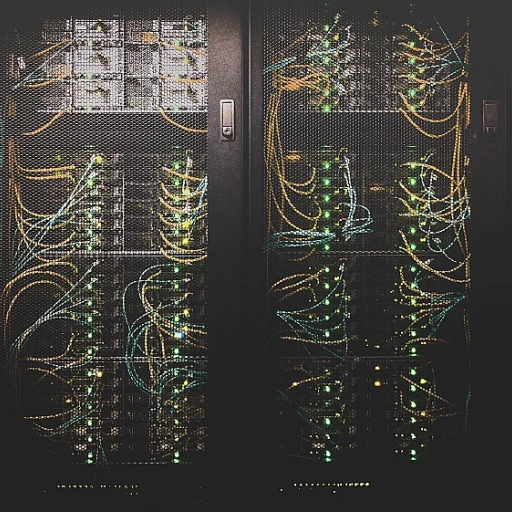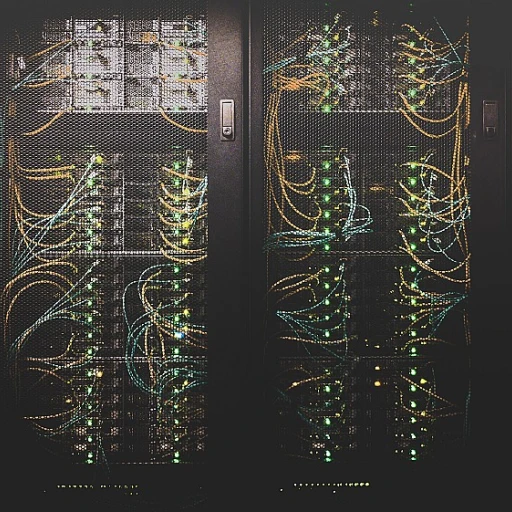
The Role of Networking Tools in Modern Software Development
The Backbone of Modern Development
In the realm of software development, networking tools have become indispensable. They form the backbone of modern development environments, enabling seamless communication and data exchange between various components and teams. These tools are essential for monitoring network performance, managing network devices, and ensuring that data flows efficiently across systems.
Networking tools facilitate real-time collaboration, which is crucial in today's fast-paced development cycles. They help developers monitor network traffic, optimize network performance, and troubleshoot issues swiftly. With the rise of remote work, the importance of these tools has only grown, as they enable teams to work together from different locations without missing a beat.
Key Features and Benefits
Modern networking tools come equipped with a range of features that enhance their utility. From network monitoring to traffic management, these tools offer comprehensive solutions to common networking challenges. Some key features include:
- Network Monitoring: Tools like ManageEngine OpManager and Datadog Network provide real-time insights into network traffic and performance, helping teams identify and resolve issues quickly.
- Device Management: Effective management of network devices is crucial for maintaining system stability and performance. These tools allow for seamless integration and management of various devices within a network.
- Performance Optimization: By analyzing data and traffic patterns, networking tools help optimize network performance, ensuring that resources are used efficiently.
For those exploring the evolution of agile software methodologies, understanding the role of networking tools is essential. These tools not only support agile practices but also enhance the overall efficiency of software development processes. For more insights, you can explore the evolution of agile software methodologies.
Emerging Trends in Networking Tools
Innovative Shifts in Networking Tools
In the rapidly evolving landscape of software development, networking tools are undergoing significant transformations. These changes are driven by the need for enhanced network performance, improved data management, and the ability to handle increasing network traffic. As developers and IT professionals seek to optimize their systems, several emerging trends are shaping the future of networking tools.
Real-Time Monitoring and Management
One of the most notable trends is the shift towards real-time monitoring and management. Tools like ManageEngine OpManager and Datadog Network are leading the charge, offering comprehensive solutions that allow for continuous network monitoring. These tools provide insights into network devices and network traffic, enabling teams to address issues promptly and maintain optimal network performance.
Open Source and Free Trials
The rise of open source solutions and free trials is another trend gaining momentum. Developers are increasingly turning to open source tools for their flexibility and cost-effectiveness. These tools often come with robust communities that contribute to their continuous improvement. Additionally, many providers offer day free trials, allowing teams to test the key features of a tool before committing to a purchase.
Advanced Network Cabling and Fiber Optics
As the demand for faster and more reliable networks grows, advancements in network cabling and fiber optics are becoming crucial. Fiber optic technology is increasingly being adopted for its ability to transmit data at high speeds over long distances, making it a preferred choice for modern networking tools. This shift is expected to continue as organizations strive to enhance their network performance.
For more insights into how these trends are influencing software development, consider embracing the evolution of adaptive software development.
Networking Tools and Cybersecurity Challenges
Addressing Security Concerns in Networking Tools
As software development evolves, the integration of networking tools becomes increasingly vital. However, this evolution brings forth significant cybersecurity challenges. The need to secure data and maintain network integrity is paramount, especially with the rise of remote work and the proliferation of network devices.
Networking tools, such as network monitoring systems, play a crucial role in identifying potential threats in real time. These tools help monitor network traffic and performance, ensuring that any anomalies are detected promptly. The ability to manage network devices effectively is essential for maintaining a secure environment.
Key Features for Enhanced Security
- Real-Time Monitoring: Tools like ManageEngine OpManager and Datadog Network provide real-time insights into network traffic, helping to identify suspicious activities quickly.
- Data Encryption: Ensuring that data is encrypted during transmission across network cables and fiber optics is critical for protecting sensitive information.
- Access Control: Implementing strict access controls on network devices and systems can prevent unauthorized access and potential breaches.
- Open Source Solutions: Some organizations opt for open source network tools, which offer flexibility and transparency, allowing for thorough security audits.
While these tools offer robust solutions, they also present challenges. The complexity of managing multiple devices and systems can lead to vulnerabilities if not handled properly. Regular updates and patches are necessary to address any security loopholes.
In conclusion, the future of networking tools in software development will heavily rely on their ability to adapt to emerging cybersecurity threats. As developers and IT professionals continue to innovate, the focus will remain on creating secure, efficient, and reliable networking environments.
Impact of Networking Tools on Remote Work
Remote Work Revolution: Networking Tools at the Forefront
The shift to remote work has dramatically transformed how businesses operate, with networking tools playing a pivotal role in this evolution. As organizations continue to adapt to this new normal, the demand for efficient network management and monitoring tools has surged. These tools ensure seamless communication and collaboration, which are essential for maintaining productivity in a distributed workforce.
One of the key challenges in remote work is ensuring network performance and reliability. With employees accessing company resources from various locations, network traffic can become unpredictable. Tools like network monitors and network performance management systems help in tracking and optimizing data flow, ensuring that all network devices function efficiently. This is crucial for maintaining the quality of service and preventing disruptions.
Moreover, the integration of fiber optic technology and advanced network cabling solutions has enhanced the speed and reliability of connections. These advancements allow for real-time data transmission, which is vital for remote teams relying on video conferencing and cloud-based applications. The ability to monitor and manage these systems in real time is a game-changer for IT departments tasked with supporting a remote workforce.
Additionally, the rise of open source networking tools offers companies a cost-effective way to manage their networks. Many of these tools come with a free trial period, allowing businesses to evaluate their effectiveness before committing to a purchase. This flexibility is particularly beneficial for small to medium-sized enterprises looking to optimize their network infrastructure without significant financial investment.
Tools like ManageEngine OpManager and Datadog Network provide comprehensive solutions for network monitoring and management. These platforms offer key features such as traffic analysis, device monitoring, and performance optimization, which are essential for supporting remote work environments. By leveraging these tools, businesses can ensure that their network systems remain robust and resilient, even as they navigate the complexities of a distributed workforce.
The Future of Networking Tools: Predictions and Innovations
Anticipating the Next Generation of Networking Tools
The future of networking tools in software development is poised for transformative changes. As technology evolves, these tools are expected to become more sophisticated, offering enhanced capabilities for network monitoring and management. The integration of artificial intelligence and machine learning will likely play a pivotal role in this evolution, enabling real-time data analysis and predictive insights into network performance.
AI and Machine Learning: The Game Changers
AI-driven tools will revolutionize how we monitor and manage network traffic. By leveraging machine learning algorithms, these tools can predict potential network issues before they occur, allowing for proactive management. This predictive capability will be crucial for maintaining optimal network performance and minimizing downtime.
Embracing Open Source and Free Trials
Open source solutions and free trials will continue to gain traction, providing developers with cost-effective options to test and implement networking tools. These offerings will allow teams to explore various tools without significant financial commitments, ensuring they choose the best fit for their specific needs.
Fiber Optic and Advanced Cabling Technologies
As data demands increase, the adoption of fiber optic and advanced cabling technologies will become more prevalent. These technologies offer superior speed and reliability, essential for supporting the high-performance requirements of modern software systems. Networking tools will need to adapt to manage these advanced infrastructures effectively.
Enhancing Security with Advanced Monitoring
With cybersecurity challenges on the rise, future networking tools will need to incorporate robust security features. Enhanced network monitoring capabilities will be critical in detecting and mitigating threats in real time, ensuring the safety of network devices and data.
Conclusion
The future of networking tools is bright, with innovations that promise to enhance efficiency, security, and performance. As these tools evolve, they will continue to play a vital role in the success of software development projects, adapting to the ever-changing technological landscape.
Choosing the Right Networking Tools for Your Project
Evaluating Your Project Needs
When selecting networking tools for your software development project, it's crucial to start by evaluating your specific needs. Consider the scale of your project, the number of network devices involved, and the type of data traffic you expect. Are you dealing with a complex system that requires robust network monitoring and management tools, or is a simpler solution sufficient? Understanding these requirements will guide your choice of tools, whether you need advanced network performance monitoring or basic network cabling solutions.
Key Features to Consider
Once you've assessed your needs, focus on the key features that will support your project goals. Look for tools that offer real-time monitoring capabilities, as these can provide immediate insights into network traffic and performance. Tools like ManageEngine OpManager and Datadog Network are known for their comprehensive monitoring services. Additionally, consider whether the tool offers a free trial, allowing you to test its functionality before committing.
Budget and Cost Considerations
Budget is always a critical factor in choosing the right networking tools. Some tools offer free versions or open-source alternatives, which can be beneficial for smaller projects or those with limited budgets. However, for larger projects, investing in a more robust tool network with advanced features might be necessary. It's important to weigh the cost against the benefits, ensuring that the tool's capabilities align with your project's demands.
Integration and Compatibility
Another important aspect is the tool's compatibility with your existing systems and devices. Ensure that the networking tools you choose can seamlessly integrate with your current infrastructure, whether it's fiber optic cabling or other network devices. This will help avoid potential disruptions and ensure smooth operation.
Scalability and Future-Proofing
Finally, consider the scalability of the networking tools. As your project grows, your networking needs will evolve. Opt for tools that can scale with your project, offering flexibility and adaptability. This will help future-proof your network management strategy, ensuring that your tools remain effective as your project expands.















